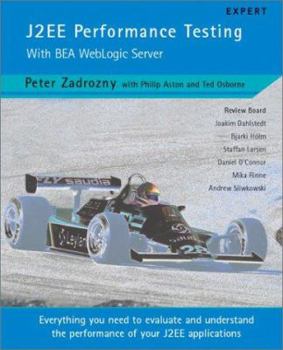J2ee Performance Testing
Performance is the single biggest issue facing J2EE Application developers and is the major concern of organizations considering J2EE adoption. This title provides the methodology and tools required... This description may be from another edition of this product.
Format:Paperback
Language:English
ISBN:1904284000
ISBN13:9781904284000
Release Date:April 2002
Publisher:Wrox Press
Length:496 Pages
Weight:1.80 lbs.
Dimensions:1.1" x 7.3" x 9.0"
Customer Reviews
5 ratings
A good introduction
Published by Thriftbooks.com User , 19 years ago
In the last decade, the performance of J2EE applications has become of monumental importance in enterprise industries that use these applications. With the complexity of J2EE applications increasing every year, it is crucial that users of these applications be presented with a level of performance that is acceptable to them, this performance usually codified in the ubiquitous "response time." The authors of this book have given a good introduction of how to deal with performance issues in WebLogic applications and have discussed a freely available tool, called Grinder, which allows load-generating and data collection. The book though can be read with respect to any load-generating tool, such as Mercury LoadRunner, etc. Even though Grinder is free, it may take time for enterprise users to trust it in testing and modeling. After a brief introduction to what the book is all about, the authors begin in chapter 1 with discussion on a testing methodology for doing performance studies of J2EE applications, which they hope will be generic enough for all readers. Their methodology boils down to first defining the performance metrics for the application, and then setting a target for the metrics. Test scripts that accurately simulate the application usage must then be obtained, and the statistical sampling method and metrics must then be defined. The authors emphasize the need for a realistic `usage profile' for the application, and they recommend strongly a fixed number of users per test run, with subsequent runs changing the number of users. They do not give quantitative reasons for not varying the number of users, but merely say that such an approach is "statistically incorrect." They also point out the need for including "think times" between the executions of each request in a script, asserting that the think times will have a very dramatic effect on the observed response times and throughput for a given user load. They are correct in this claim, as testing and modeling studies will show, and they give examples of this in chapter 4 of the book. In addition, they remark that the attempt to simulate more users by decreasing the think time, with the assumption that the resulting data can be then extrapolated to obtain the performance at real think times. They point out, correctly, that applications do not scale linearly over different time scales, and that the application and Web servers, the database server, and the operating system do not interact the same way with different user loads. Performance testers and modelers have verified them time and time again, and so it is beneficial for a reader who might be new to the field to see the case studies illustrating this included in the book. The authors discuss two sampling methods in the book, namely the `cycle' method, and the `snapshot' method. Defining a cycle as a complete execution of a test script by a simulated user, each user will thus execute every request in the script once. Increasing the numbe
Excellent Read
Published by Thriftbooks.com User , 21 years ago
I was looking for a book to help me understand how regular performance testing is performed so that I could construct a plan to do Denial of Service security testing. I knew nothing about performance testing at all. The books really well laid out, structured, has great examples and is really methodical. It was perfect !
J2EE Performance Testing with BEA WebLogic Server
Published by Thriftbooks.com User , 21 years ago
It was a great book! Had lots of information about Performance Testing. When coupled with the power of Panorama(TM) by Altaworks.com, it is incredible.
Superb book about performance tuning
Published by Thriftbooks.com User , 21 years ago
This is the best book yet about J2EE performance tuning. I hope 'Expert Press' (which looks like a Wrox imprint) continues as they have started. The authors lay out a practical method for performance tuning of Web Applications and EJB's on BEA Weblogic, but there is no reason why the approach (and the 'Grinder' tool) cannot be used to evaluate different approaches on any other Web and Application server. Note that this is a specialized book. It will not teach you how to do Java or EJBs. What it will do is help you evaluate how to deploy them in the real world to get the performance you need, and also to help you evaluate different approaches.
EBJ chapter rocks
Published by Thriftbooks.com User , 21 years ago
Thanks for making such a good book avaliable. I think the chapter on testing EJB design patterns is very well written. I would recommend this book as it is one of the best I've gotten my hands on.




